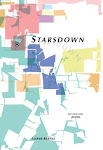Because I've Been Reading Lots of Ange Mlinko Poems
Announcing my trip to New York got me thinking about how much I love the neighborhood where I usually stay when I go there these days, where one of my oldest and dearest friends lives, in a swaybacked, tilting edifice that will soon, if it's not condemned, collapse, taking with it the rest of the doomed neighborhood. Barricaded on three sides, more a cul-de-sac than a neighborhood, it’s not very well known, even among friends who’ve lived in NYC for decades. Recently, he tells me, one of the many, ancient out-buildings on the property collapsed, and the tenants, knowing that they lived in some of the very last affordable apartments in all of New York City, rented a van and quietly cleared away the debris before it alerted the no-doubt senescent, probably fictitious, owners to the perilous state of suspension in which the building proper stood. The property abuts a vacant lot of dead cars and other gorgeous detritus the exact dimensions of which I've never been able to gauge, so overgrown is it with the kinds of prodigious trees that no-one bothers to remember the names for. Perhaps it's infinite, that lot.
Behind this property is a first-five-minutes-of-a-horror-movie gated mansion with many once-elegant vehicles parked on its premises, and behind that you can see the open tanks of the sewage processing plants they like to put in these neighborhoods. Anywhere anybody I know who lives in New York lives is always within olfactory range of one of these. And, behind the mansion, the barracks and officer’s housing of the Naval Yard. Or, depending on which way you look, the projects.
In the other direction, far too close actually for an encounter with the industrial sublime, there’s a Sheeleresque power plant that, on hot days, in summer, emits the kind of noises a power plant might make if it thought it were imitating a sick cat. The heat waves roiling off it are entertainment enough for drinking on porches.
But then, the neighborhood itself, the neighborhood proper, is cobblestone streets, 19th-century storefronts, and street names that bespeak a vanished world of small merchants and craftspeople and other non-existents: Gold St., for instance. It’s Whitman’s Brooklyn, and indeed, his beloved ferry is only a few blocks and one-hundred twenty years away, where it meets Crane’s Brookyn, on the other side of the two bridges.
So, it’s a dialectical image, this neighborhood. The smaller, picturesque scale of the 19th century, seemingly livable only because of the patina of time, meeting smack against the inhuman, definitively unlivable dimensions of the 20th. Rendering both parties, once tragedies, farcical. And between them both, home. Except that, everywhere, in every direction on the horizon these days, the new farces: the gentrification-lesions, the sleek speculative highrises of 21st-century Brooklyn come to end this little détente of the dialectic. If the timing’s right, the sound of the trucks on the BQE bouncing off their shiny, echoic and life-resistant surfaces makes it sound as if they were whispering to each other more gossip about Frank Gehry.


